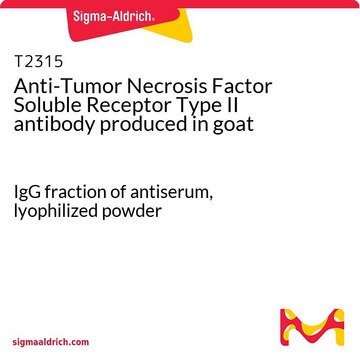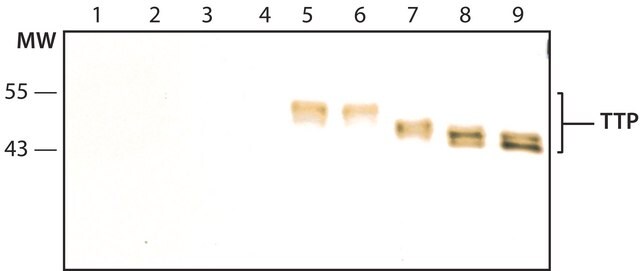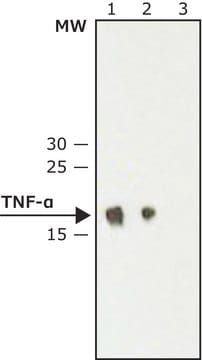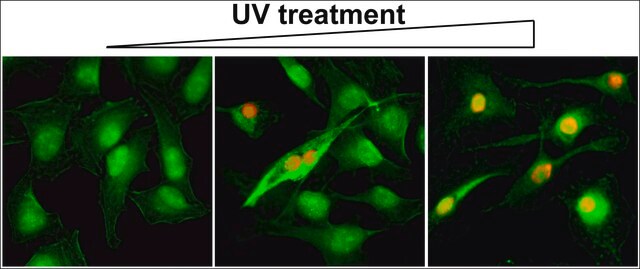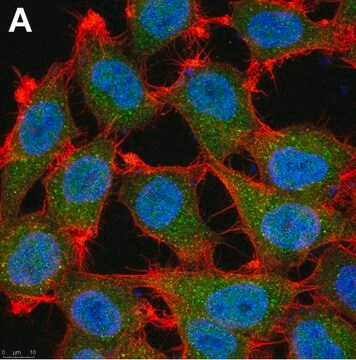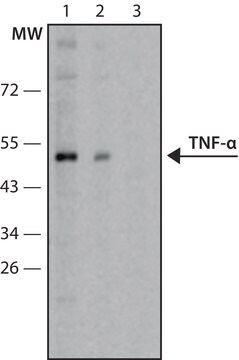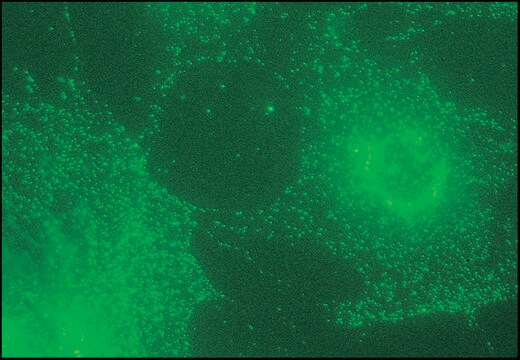T1815
Monoclonal Anti-Tumor Necrosis Factor Receptor II antibody produced in mouse
clone 22221, purified immunoglobulin, lyophilized powder
Synonym(s):
Anti-TNF RII, Anti-TNFRSF1B
Sign Into View Organizational & Contract Pricing
All Photos(1)
About This Item
Recommended Products
biological source
mouse
Quality Level
conjugate
unconjugated
antibody form
purified immunoglobulin
antibody product type
primary antibodies
clone
22221, monoclonal
form
lyophilized powder
species reactivity
human
technique(s)
immunocytochemistry: 8-25 μg/mL using immersion fixed human peripheral blood lymphocytes
microarray: suitable
neutralization: suitable
isotype
IgG2a
UniProt accession no.
storage temp.
−20°C
target post-translational modification
unmodified
Gene Information
human ... TNF(7124)
General description
The tumor necrosis factor super family (TNFSF) consists of at least 19 transmembrane proteins with soluble forms that are generated by proteolysis. The biological effects of TNF are mediated by either type I or type II receptors. Type I receptors that are ubiquitously present on all cells whereas type II receptors are expressed only on cells of immune system (monocytes, macrophages, Langerhans cells) and endothelial cells. Receptors of TNFSF such as TNFR I and Fas have their own death domains that activate the apoptosis. Other receptors such as TNFR II do not have death domains and utilize TNF associated factors (TRAFs) to activate intracellular signaling. TNFR II activates NF-κB pathway via the activation of NIK. Monoclonal Anti-Tumor Necrosis Factor Receptor II antibody recognizes human TNFR II.
Specificity
The antibody neutralizes the biological effect of recombinant human TNF RII. It does not neutralize or cross-react with TNF RI.
Immunogen
recombinant human tumor necrosis factor receptor II, expressed in Escherichia coli.
Application
Anti-Tumor Necrosis Factor Receptor II antibody may be used for immunocytochemistry at a working concentration of 8-25 μg/ml using human peripheral blood lymphocytes. The antibody is suitable for neutralization assays and protein microarray. The antibody was used for flow cytometry using human CD8 T cells.
Physical form
Lyophilized from a 0.2 μm filtered solution in phosphate buffered saline containing carbohydrates.
Preparation Note
Purified using protein A
Disclaimer
Unless otherwise stated in our catalog or other company documentation accompanying the product(s), our products are intended for research use only and are not to be used for any other purpose, which includes but is not limited to, unauthorized commercial uses, in vitro diagnostic uses, ex vivo or in vivo therapeutic uses or any type of consumption or application to humans or animals.
Not finding the right product?
Try our Product Selector Tool.
Storage Class
12 - Non Combustible Liquids
wgk_germany
WGK 1
flash_point_f
Not applicable
flash_point_c
Not applicable
Choose from one of the most recent versions:
Already Own This Product?
Find documentation for the products that you have recently purchased in the Document Library.
Liqin Ban et al.
Proceedings of the National Academy of Sciences of the United States of America, 105(36), 13644-13649 (2008-08-30)
Human autoimmune (AI) diseases are difficult to treat, because immunosuppressive drugs are nonspecific, produce high levels of adverse effects, and are not based on mechanistic understanding of disease. Destroying the rare autoreactive T lymphocytes causing AI diseases would improve treatment.
The Role of Costimulatory Receptors of the Tumour Necrosis Factor Receptor Family in Atherosclerosis
Antunes RF et al
Journal of Biomedicine and Biotechnology, doi: 10-doi: 10 (2012)
B B Aggarwal
Annals of the rheumatic diseases, 59 Suppl 1, i6-16 (2000-10-29)
Tumour necrosis factor (TNF) is a pleiotropic cytokine that mediates apoptosis, cell proliferation, immunomodulation, inflammation, viral replication, allergy, arthritis, septic shock, insulin resistance, autoimmune diseases, and other pathological conditions. TNF transduces these cellular responses through two distinct receptors: type I
M Lotz et al.
Journal of leukocyte biology, 60(1), 1-7 (1996-07-01)
Receptors in the nerve growth factor/tumor necrosis factor receptor family are characterized by the presence of cysteine-rich motifs of approximately 40 amino acids in the extracellular domain. The ligands are type II transmembrane proteins with beta-strands that form a jelly-roll
Joana Gonçalves et al.
The European journal of neuroscience, 31(2), 315-326 (2010-01-16)
Methamphetamine (METH) causes irreversible damage to brain cells leading to neurological and psychiatric abnormalities. However, the mechanisms underlying life-threatening effects of acute METH intoxication remain unclear. Indeed, most of the hypotheses focused on intra-neuronal events, such as dopamine oxidation, oxidative
Our team of scientists has experience in all areas of research including Life Science, Material Science, Chemical Synthesis, Chromatography, Analytical and many others.
Contact Technical Service